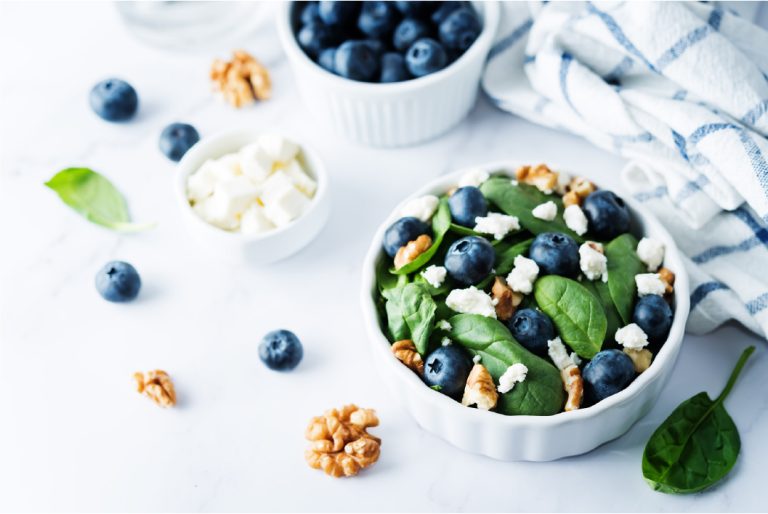Benefiting from Blueberries – Plus Bonus Recipe

by Kirsten Romero, Wellness Dietitian, Senior Services of Southeastern Virginia
As discussed in my previous blogs, the MIND Diet promotes eating more plant-based foods with limited animal and high saturated fat foods. MIND Diet guidelines encourage eating more nuts, beans, whole grains, fish rich in omega-3 fats, and plenty of fruits and vegetables, especially leafy greens, and blueberries. This way of eating is good for your heart and your brain and may also help to lower the risk of other chronic diseases. Blueberries deserve special attention; these little nutrient powerhouses have numerous health benefits.
Health experts agree that blueberries are one of the healthiest fruits you can eat. For just 65 calories, ¾ cup blueberries contains vitamin C, vitamin K, manganese, and fiber. They’re naturally low in calories and virtually fat free. Blueberries contain many phytochemicals, chemicals produced by plants, including a high level of anthocyanins which give blueberries their brilliant color. Anthocyanins are associated with reduced cardiovascular disease, death, and type 2 diabetes, and with improved weight maintenance and protection of brain health. Their antioxidant properties help prevent oxidative damage which is linked to aging, heart disease, and cancer.
Studies about the health benefits of eating blueberries have shown very promising results, including:
- A University of Cincinnati study showed improved memory function and mood in older adults with early memory decline with a blueberry-supplemented diet.
- A team at the Harvard School of Public Health reported the risk of heart attack was reduced by 33% in women when they ate 3 or more servings blueberries per week.
- A study at Harvard Medical School showed that eating one or more servings of blueberries every week may help slow cognitive degeneration in women.
- Animals fed blueberries developed fewer aortic plaques than in control subjects, reducing their risk of heart disease.
- Daily consumption of blueberries helps people with Type 2 diabetes improve insulin resistance and extracts from blueberries may help resolve hyperglycemia.
- Blueberries may promote beneficial intestinal bacteria which benefits digestive health and the immune system.
When buying blueberries, choose firm, plump berries with a dusty blue color and avoid shriveled or soft berries. Frozen blueberries provide the same nutritional benefits as fresh, they’re cost-effective, and they ensure you have nutritious and delicious blueberries available to eat year-round. Eat blueberries by the handful; use them as an ingredient in muffins, pancakes, and other baked goods; add to smoothies and atop yogurt; eat them right out of the freezer for a cool popsicle-like treat; and add them to savory recipes and salads.
Try this easy nutrient packed recipe:
Blueberry Summer Salad
Yield: 4-6 people
adapted from howsweeteats.com
Ingredients
Salad:
- ½ cup sliced almonds
- 2 tablespoons sugar
- 8 cups spinach or dark leafy greens of choice
- salt and pepper to taste
- 2 cucumbers, thinly sliced
- 4 green onions, thinly sliced (optional)
- 1 cup blueberries
- ¼ cup finely grated parmesan cheese
Creamy Balsamic Vinaigrette:
- ¼ cup balsamic vinegar
- 1 garlic clove, minced or pressed
- 2 tablespoons nonfat Greek yogurt or sour cream
- 2 teaspoons Dijon mustard
- 2 teaspoons honey
- pinch of salt and pepper
- ½ cup extra virgin olive oil
Instructions
Salad:
- Place the almonds in a nonstick skillet over medium heat. Stir in the sugar and cook, stirring often, until the sugar melts and is caramel-like, coating all of the almonds – about 6 to 8 minutes. Don’t take your eyes off this as they can burn quickly! Transfer the almonds to a piece of parchment or wax paper to let them cool. Break them into pieces if they are clumped.
- In a large bowl, toss the greens with a pinch of salt and pepper. Sprinkle on the blueberries, cucumbers, green onions (if used) and parmesan cheese. Add the almonds on top. Serve immediately with the balsamic dressing!
Creamy Balsamic Vinaigrette:
- Whisk together the vinegar, garlic, yogurt, mustard, honey and a pinch of salt and pepper. Stream in the olive oil while whisking until emulsified. Pour over the salad and toss well.
Note: This dressing stays great in the fridge. Just shake or whisk it to combine before serving.